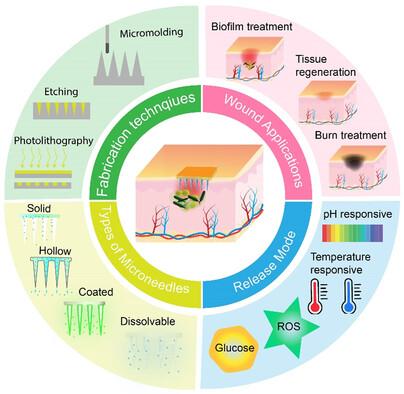Development of Microneedles for Antimicrobial Drug Delivery: A Comprehensive Review on Applications in Wound Infection Management
IF 11.1
Q1 MATERIALS SCIENCE, MULTIDISCIPLINARY
引用次数: 0
Abstract
Microneedles (MNs) have emerged as a promising transdermal antimicrobial delivery system, providing precise and localized drug delivery while complemented with noninvasiveness and patient compliance. Currently, the topical application of antimicrobials restricts the delivery of drugs to the critical areas of the wound bed, largely due to barriers posed by the necrotic tissue, scab formation, and bacterial biofilms, which severely diminish the bioavailability of the therapeutics. MNs have enabled efficient and targeted delivery to overcome many chronic wound challenges. Over the past decade, significant progress has been made to develop MNs with unique properties tailored for the delivery of vaccines, anticancer, and antimicrobials. As ongoing research continues to refine MN design, material properties, and drug formulations, the potential for revolutionizing antimicrobial drug delivery for efficacy, patient experience, and therapeutic outcomes remains at the forefront of scientific research. In this review, insights are provided into the latest progress, current developments, and the diverse applications of MNs for antimicrobial drug delivery. Herein, the translational potential of MNs is highlighted and a perspective on the current challenges associated with clinical translation is provided. Furthermore, this review aids in identifying research gaps while empowering and contributing to the future implementation of cutting-edge delivery systems to effectively tackle antimicrobial resistance.

开发用于抗菌药物传输的微针:伤口感染管理应用综述
微针(MNs)已成为一种前景广阔的透皮抗菌给药系统,可提供精确的局部给药,同时还具有无创和病人顺应性等优点。目前,局部应用抗菌药会限制向伤口床关键区域给药,这主要是由于坏死组织、痂皮形成和细菌生物膜造成的障碍,严重降低了治疗药物的生物利用度。多孔介质可实现高效、有针对性的给药,从而克服许多慢性伤口难题。过去十年来,在开发具有独特性能的 MNs 方面取得了重大进展,这些 MNs 专门用于输送疫苗、抗癌药物和抗菌药物。随着正在进行的研究不断完善 MN 的设计、材料特性和药物配方,彻底改变抗菌药物递送的疗效、患者体验和治疗结果的潜力仍处于科学研究的前沿。在这篇综述中,我们将深入探讨抗菌药物递送的最新进展、当前发展以及 MNs 的各种应用。本综述强调了 MNs 的转化潜力,并透视了当前与临床转化相关的挑战。此外,这篇综述还有助于确定研究缺口,同时为未来实施尖端给药系统以有效解决抗菌药耐药性问题提供依据并做出贡献。
本文章由计算机程序翻译,如有差异,请以英文原文为准。
求助全文
约1分钟内获得全文
求助全文
来源期刊
CiteScore
14.00
自引率
2.40%
发文量
0
期刊介绍:
Small Science is a premium multidisciplinary open access journal dedicated to publishing impactful research from all areas of nanoscience and nanotechnology. It features interdisciplinary original research and focused review articles on relevant topics. The journal covers design, characterization, mechanism, technology, and application of micro-/nanoscale structures and systems in various fields including physics, chemistry, materials science, engineering, environmental science, life science, biology, and medicine. It welcomes innovative interdisciplinary research and its readership includes professionals from academia and industry in fields such as chemistry, physics, materials science, biology, engineering, and environmental and analytical science. Small Science is indexed and abstracted in CAS, DOAJ, Clarivate Analytics, ProQuest Central, Publicly Available Content Database, Science Database, SCOPUS, and Web of Science.

 求助内容:
求助内容: 应助结果提醒方式:
应助结果提醒方式:


